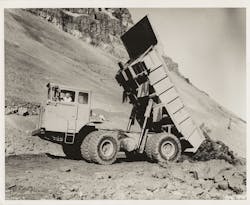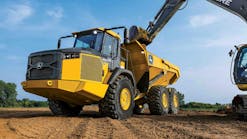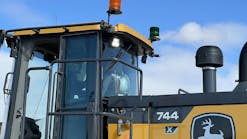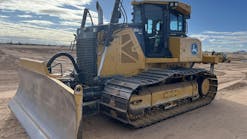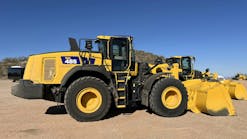By Roger Amato, HCEA National Director
International Harvester gained entry into the off-highway hauler market through the back door, so to speak. As early as the 1930s, The Heil Co. had manufactured heavy-duty dump boxes, and Heil boxes were by far the most numerous used at Boulder Dam. Heil went on to develop the MW-20, a 20-cubic-yard bottom-dump wagon for use with its 2C800 two-wheeled prime mover, a tractor that was primarily used with scrapers. When IH acquired the Heil scraper line in 1953, the MW-20 was included.
John L. McCaffrey, president of IH at the time, began his career with IH as a truck salesman and was certain that with the company’s long experience with on-road trucks, it could compete as well in off-road haulers. The first IH haulers, the 65 and 95 Payhaulers, were launched in 1956. The 95 was replaced by the larger 100 in 1963.
The next year, a radically new Payhauler, the Model 180, was introduced. It featured four-wheel-drive on a rigid frame with same-size dual tires in front and back for better weight distribution. It also had a lower profile than other large off-road trucks and boasted a 70 degree maximum dumping angle, the highest in the industry. With nothing else like it at the time, it drew considerable interest from both mining companies and heavy contractors. It was rated at 45 tons or 34 yards, and was powered by a 433-horsepower Detroit Diesel 12V-71N engine.
The 180 sold well, and in 1968, the company launched an additional 180 Payhauler model with a 50-ton rating, as well as two new Model 140 trucks with 36- and 40-ton capacities. The 50-ton Model 180 was available with either a Detroit Diesel 16V-71N or a Cummins VT-1710C, both producing 537 horsepower. The two versions of the Model 140 had IH DT-817B engines with 394 fwhp. Both of the new Payhauler truck models were equipped with an all-wheel retarding system to minimize braking when travelling downhill with a load.
IH revamped the Payhauler line in 1973, replacing the 140 and 180 with three new units: the 36-ton capacity Model 330, 40-ton Model 340, and the 50-ton Model 350. All had the four-wheel drive and dual tires from the Models 140 and 180 design as well as similar engines, and were slightly heavier. A coal-hauling version of the 350 was also offered with extra high sides on its dump box, enabling it to carry up to 82 yards heaped. The Models 330 and 340 were discontinued in 1979. The 350 was upgraded to the 350B with same capacity but with a substantial increase in power: either a two-cycle 580-horsepower Detroit Diesel 16V-71N-65 or a four-cycle 607-fwhp Cummins VT-1710C engine, and a six-speed powershift transmission with electronic shift control.
Along with the 300 Series two-axle trucks launched in 1973, IH offered two Athey Products bottom-dump trailers for the Model 350 truck. The PW-350 Payhauler wagon was designed for hauling sand, gravel, or dirt; it was equipped with dual 8-foot diameter tires and could carry up to 71 yards heaped. The other trailer was the PH-350, designed for coal hauling. It had higher sides and could carry up to 136 yards heaped. Both units were rated at 100 tons maximum load weight.
IH was in serious financial trouble in the early 1980s and had to divest itself of most of its business lines, including construction equipment. In 1982, IH sold the Payhauler line, which by then consisted of only the 350B truck, to the group of employees involved in its assembly and management. The group correctly believed that the market for the truck would remain strong enough to support a company with one product. The new company was named the Payhauler Corp., and its facilities were moved to Batavia, Illinois.
The 350B Payhauler was replaced by the 350C in 1988. Its capacity was increased to 55 tons (42 yards), and power increased to 635 ghp from a Detroit Diesel 16V-71N engine. Payhauler Corp. was purchased by Terex in 1999, and Terex continued offering the Model 350C truck until 2006. It was available with the same 55-ton dump body and two engine options: Cummins QSK-19 with 635 ghp/607 fwhp, or Caterpillar 3408 HEUI with 625 ghp/597 fwhp.
The Historical Construction Equipment Association (HCEA) is a 501(c)3 nonprofit organization dedicated to preserving the history of the construction, dredging and surface mining equipment industries. With over 3,800 members in 25countries, our activities include publication of a quarterly educational magazine, Equipment Echoes, from which this article is adapted; operation of National Construction Equipment Museum and archives in Bowling Green, Ohio; and hosting an annual working exhibition of restored construction equipment. Our next International Convention and Old Equipment Exhibition will be September 22-24, 2023, at the National Construction Equipment Museum in Bowling Green, Ohio. The HCEA is raising funds for construction of a new purpose-built building to house its equipment collection, and the Convention will feature groundbreaking for it.
Individual annual memberships in the HCEA are $35 within the U.S. and Canada, and $55US elsewhere. We seek to develop relationships in the equipment manufacturing industry, and we offer a college scholarship for engineering and construction management students. Information is available at www.hcea.net, or by calling 419.352.5616 or e-mailing [email protected].
